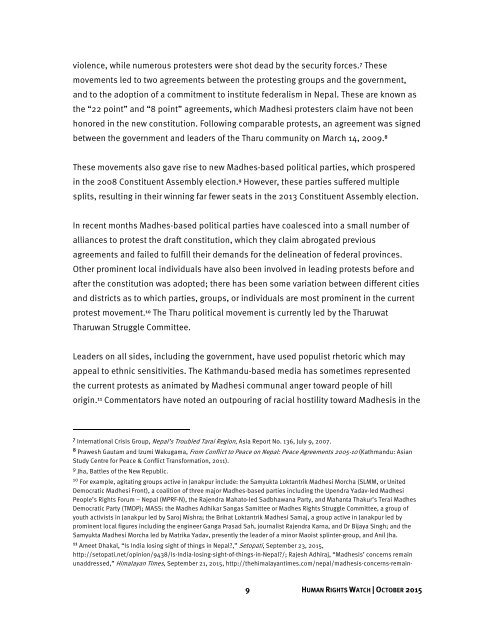“Like We Are Not Nepali”
7KiiNLWaT
7KiiNLWaT
You also want an ePaper? Increase the reach of your titles
YUMPU automatically turns print PDFs into web optimized ePapers that Google loves.
violence, while numerous protesters were shot dead by the security forces. 7 These<br />
movements led to two agreements between the protesting groups and the government,<br />
and to the adoption of a commitment to institute federalism in Nepal. These are known as<br />
the “22 point” and “8 point” agreements, which Madhesi protesters claim have not been<br />
honored in the new constitution. Following comparable protests, an agreement was signed<br />
between the government and leaders of the Tharu community on March 14, 2009. 8<br />
These movements also gave rise to new Madhes-based political parties, which prospered<br />
in the 2008 Constituent Assembly election. 9 However, these parties suffered multiple<br />
splits, resulting in their winning far fewer seats in the 2013 Constituent Assembly election.<br />
In recent months Madhes-based political parties have coalesced into a small number of<br />
alliances to protest the draft constitution, which they claim abrogated previous<br />
agreements and failed to fulfill their demands for the delineation of federal provinces.<br />
Other prominent local individuals have also been involved in leading protests before and<br />
after the constitution was adopted; there has been some variation between different cities<br />
and districts as to which parties, groups, or individuals are most prominent in the current<br />
protest movement. 10 The Tharu political movement is currently led by the Tharuwat<br />
Tharuwan Struggle Committee.<br />
Leaders on all sides, including the government, have used populist rhetoric which may<br />
appeal to ethnic sensitivities. The Kathmandu-based media has sometimes represented<br />
the current protests as animated by Madhesi communal anger toward people of hill<br />
origin. 11 Commentators have noted an outpouring of racial hostility toward Madhesis in the<br />
7 International Crisis Group, Nepal’s Troubled Tarai Region, Asia Report No. 136, July 9, 2007.<br />
8 Prawesh Gautam and Izumi Wakugama, From Conflict to Peace on Nepal: Peace Agreements 2005-10 (Kathmandu: Asian<br />
Study Centre for Peace & Conflict Transformation, 2011).<br />
9 Jha, Battles of the New Republic.<br />
10 For example, agitating groups active in Janakpur include: the Samyukta Loktantrik Madhesi Morcha (SLMM, or United<br />
Democratic Madhesi Front), a coalition of three major Madhes-based parties including the Upendra Yadav-led Madhesi<br />
People’s Rights Forum – Nepal (MPRF-N), the Rajendra Mahato-led Sadbhawana Party, and Mahanta Thakur’s Terai Madhes<br />
Democratic Party (TMDP); MASS: the Madhes Adhikar Sangas Samittee or Madhes Rights Struggle Committee, a group of<br />
youth activists in Janakpur led by Saroj Mishra; the Brihat Loktantrik Madhesi Samaj, a group active in Janakpur led by<br />
prominent local figures including the engineer Ganga Prasad Sah, journalist Rajendra Karna, and Dr Bijaya Singh; and the<br />
Samyukta Madhesi Morcha led by Matrika Yadav, presently the leader of a minor Maoist splinter-group, and Anil Jha.<br />
11 Ameet Dhakal, “Is India losing sight of things in Nepal?,” Setopati, September 23, 2015,<br />
http://setopati.net/opinion/9438/Is-India-losing-sight-of-things-in-Nepal?/; Rajesh Adhiraj, “Madhesis’ concerns remain<br />
unaddressed,” Himalayan Times, September 21, 2015, http://thehimalayantimes.com/nepal/madhesis-concerns-remain-<br />
9 HUMAN RIGHTS WATCH | OCTOBER 2015


